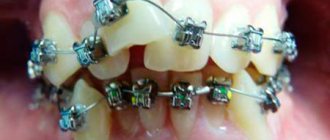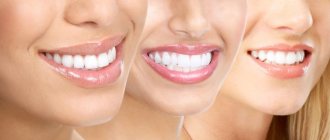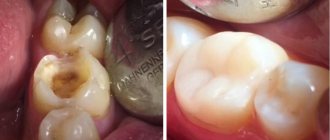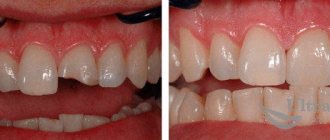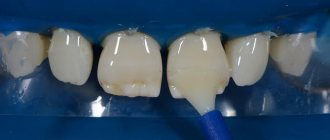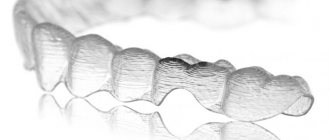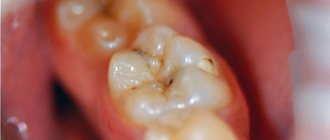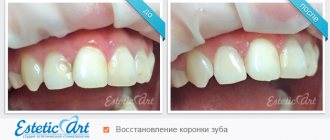Artistic or aesthetic restoration is a set of procedures to improve the appearance of teeth. With their help, you can hide complex and visible defects in enamel and return it to its original appearance. Dentists use artificial materials whose composition is similar to natural teeth. Therefore, artistic restoration allows you to achieve the optimal color combination of the filling and the remaining teeth. You can easily regain your lost beautiful smile in one or several visits to the doctor.
Main indications
- Visible damage to tooth enamel due to physical impact or other external factors.
- Cracks on the surface of the tooth.
- Changes in enamel color. For example, yellowing or dark areas due to illness.
- The formation of a visible gap between the teeth, which spoils the smile and causes discomfort when eating.
- Malocclusion.
- Trauma to one or more teeth.
In many cases, artistic restoration is carried out in conjunction with treatment. First, the dentist eliminates the disease and then restores the appearance of the tooth. Before the procedure, professional consultation is required. The doctor examines the patient and selects the optimal method of aesthetic restoration.
In what cases is the dental restoration procedure used?
The procedure allows you to solve the following problems:
- carious damage to most of the frontal tooth surface;
- gaps between teeth;
- chips and damage to enamel;
- more than 50% destroyed crown;
- changes in enamel shade.
Aesthetic restoration provides an opportunity to correct the shape and color of teeth. After the procedure, they look natural and match the appearance and function of healthy teeth.
The cost of such a procedure depends on the nature of the defect and the methods used to eliminate it. This issue can be discussed at a clinic appointment.
Advantages and disadvantages of direct restoration
The direct method involves the use of composite materials to restore teeth. First, the doctor conducts a diagnosis, then determines the scope of work and the color of the composite. Only after this is restoration carried out. A clear advantage of this method is its efficiency. You can restore your teeth in one visit. Other pros:
|
Despite its low cost, direct restoration is not in widespread demand in the country's leading clinics. It's all about the cons
, which have this method of restoring aesthetics:
- It is necessary to periodically visit a specialist to polish the edges.
- Composite color changes over time.
- Low strength when compared with ceramic products.
- There are contraindications. In particular, the recovery procedure cannot be performed on people who have a pacemaker.
Composite materials for restorations
Performing direct artistic restoration requires the use of reliable, color-stable and durable materials that cannot be erased.
Due to their excellent characteristics, light-curing composite materials are used in dentistry. Photocomposites have excellent adhesion to dental tissue at the molecular level and do not change their position due to the ability to diffuse into enamel and dentin, and at the same time they do not violate the aesthetic perception of the tooth. These materials are applied in very thin layers to compensate for shrinkage due to photopolymerization. If the application technology is followed, a long-term, consistently high-quality effect is achieved.
To most accurately match the material to the mechanical characteristics of the tooth and its color (everyone’s teeth are individual), dentists layer materials of different shades and properties on top of each other. The result is a complete imitation of high-strength translucent enamel.
The strength of photocomposites allows them to be used in the restoration of anterior and chewing teeth that receive maximum load. Many of these materials contain fluoride ions, which helps prevent the development of secondary caries over the entire surface of the filling.
When restoring teeth of irregular shape, their visual contour is often corrected, the corners are smoothed or, on the contrary, sharpened, giving an individual uniqueness to the smile.
The advantage of direct restoration is that all the work will be done in one visit to the dentist (2-6 hours). Modern materials are suitable for closing gaps between teeth, changing their shape, size and color.
Advantages and disadvantages of indirect restoration
The indirect method (another name is veneering) is the correction of dental defects using thin ceramic plates. This method is considered more effective, but it is also costly in terms of time and money. Stages:
|
Flaws
this method are obvious.
Firstly, indirect restoration is more expensive than the direct method. Secondly, you will have to visit a specialist at least twice. Thirdly, if a person wants to remove ceramic plates, then the teeth must be covered with crowns. And this is an additional waste of time and money. But despite these disadvantages, direct restoration is in wide demand. After all, the advantages
cover all the disadvantages of the procedure:
- The client receives a perfect, “Hollywood” smile.
- Possibility of restoring all dental defects.
- High strength plates. Ceramics are much more reliable than composites and are more resistant to external factors.
- An excellent combination of veneer colors and natural teeth.
- No complications for the patient. With the indirect method, the most labor-intensive process is making the plate in the laboratory.
- Durability. With proper care, the plates will last more than 10 years.
Important:
the procedure can be made cheaper. Many clinics offer the use of a budget material - keromer. In terms of price and performance characteristics, it is inferior to ceramics, but at the same time more reliable and more expensive than a composite.
Pros and cons of the two methods
The main advantages of the direct restoration method are:
- Maximum preservation of dental tissues, eliminating the possibility of damage to the teeth or oral cavity;
- Affordable price matches quality;
- Several teeth can be restored in one visit;
- Excellent aesthetic effect;
- Even severely damaged teeth can be restored.
Among the disadvantages of the direct method are:
- The procedure takes a long time; the patient needs to be patient in order to sit in the dentist’s chair all day;
- The dentist must have sufficient experience and professionalism to carry out restoration taking into account all the subtleties and nuances;
- After the procedure, increased oral hygiene is required, selection of a special brush and paste, regular visits to the dentist for professional cleaning and polishing;
- Over time, the color of the teeth may change and traces of restoration may become noticeable.
Advantages of using veneers
The use of ceramic veneers (as one of the most durable) with the indirect restoration method has the following advantages:
- With proper care, they will last for decades;
- Visually, they are practically no different from natural teeth;
- They are resistant to food dyes and tobacco smoke;
- The tooth is not allowed to decay further;
- Do not cause allergies;
- No discomfort for patients;
- Possibility of whitening procedures.
Disadvantages of using veneers
- Fairly high cost;
- Part of the enamel is cut down; if the veneers need to be removed, the enamel will have to be restored;
- If the preliminary installation stage is not followed, the veneers will not last long and may change color;
- The sensitivity of teeth increases, which causes pain in some patients;
- If not properly cared for, veneers can peel off and break.
It is important to understand that the main goal of dental restoration is to restore the functionality of teeth and achieve maximum aesthetic effect . That is why this procedure is very popular among patients of dental clinics who have problems with the shape and aesthetics of their teeth, who need to adjust the position of teeth in a row or eliminate gaps between teeth.
The cost of the dental restoration procedure directly depends on the chosen method and consumables; it also takes into account whether the restoration was complete or partial, and how significant the initial damage to the teeth was.
Moscow metro station Zvezdnaya, Danube Avenue, 23
Professional opinion
Experienced dentist Lilia Ayupova told Arguments and Facts why artistic restoration of teeth is the best way to restore: “The advantage of the method is the almost complete absence of preparation. In other words, during the procedure the dentist removes exclusively non-viable tissue. The method of artistic restoration allows not only to improve the appearance of teeth, but also to keep them “alive.” This is a humane way in all respects. For example, it is cheaper than installing crowns and less time consuming. But you save money without sacrificing quality.”
You can use the service at our Nikadent clinic in Mytishchi. Specialists have the best materials and tools for artistic restoration at their disposal. After the procedure, the client receives a guarantee for the services.
Restoration of chewing teeth
To restore chewing teeth, recreate their shape and the strength of hard tissues, composite materials and special inlays are used that replace the missing parts of the enamel.
Expert of the article you are reading:
Bystrov Alexey Albertovich
Dentist orthodontist, general dentist
You may also be interested in:
Ceramic veneers Lumineers price for 1 tooth in Moscow Ceramic veneers E-max
Show more
Our prices
| Name | Price |
| Tooth restoration with light-curing composite (Filtek Ultimate) | from 4,200 rub. |
| Tooth restoration with light-curing composite (Filtek Z250, Filtek Z550...)1 surface | 2,700 rub. |
| Artistic restoration (Enamel Plus) | from 4,500 rub. |
| Decorative jewelry for teeth (rhinestones) | 2,000 rub. |
| Optra Gate Overlay | 300 rub. |
| Optra Dam Plus Overlay | 400 rub. |
Fixing the composite overlay
It is produced according to the following method.
- The inner surface of the composite structure is sandblasted. Aluminum oxide sand of 30-50 microns is used.
- Treatment in an ultrasonic bath with alcohol.
- An adhesive system is applied to the inner surface, the solvent evaporates and polymerizes.
Adhesive preparation and fixation of composite restorations
1. Acid is applied to the enamel for 15 seconds. Next, the acid is applied to the dentin for 10-15 seconds.
2. The acid is washed off and the dentin is “dried”. The dentin surface is washed with a 2% chlorhexidine solution and “dried”. An adhesive system is applied.
3. The solvent evaporates and the adhesive system polymerizes. Composite cement is introduced into the tooth cavity. The inlay adapts, excess cement is polymerized within 2 seconds. And they are removed.
4. Final polymerization takes place within 40 seconds.
The onlay perfectly restores the tooth defect and is perfectly integrated in color.
BEFORE
AFTER
Whitening systems used
We use two whitening systems – Zoom and Opalescence. The main difference between them is the composition of the whitening gel, as well as how this gel is activated. Hydrogen peroxide plays the role of a key element in both systems. However, in the Zoom system its concentration is 25%, and in the Opalescence system it is 40%.
There is another important difference. In Zoom, the gel is activated by UV radiation, the sources of which are special lamps that uniformly irradiate the entire area of the enamel. And in the case of Opalescence, activation occurs naturally - the desired chemical reaction simply occurs between the components of the gel.
Regardless of which system of these two is used, the new shade will in any case only take a few days to set. And at this time, it is advisable to follow a special diet - exclude tea, cherry and pomegranate juice, red wine, tomato-based sauce, etc. from your diet.
If you maintain hygiene, the whitening results using Zoom or Opalescence can last up to one and a half years.
conclusions
The purpose of this article was to present the indications for minimally invasive treatment in addition to conservative orthodontic, prosthetic and implant treatment and to suggest possible treatment options. It should be noted that new treatments may fail when they exceed the indications for the use of specific materials and techniques. The described cases show that modern conservative dentistry has a wide range of indications and it is possible to treat a wider range of cases. Adhesive composite fiberglass bar bridges are an additional option for replacing a single missing tooth. They can also be used as high-quality, long-term provisional restorations before implantation.
Modern composites meet the expectations of the doctor and the patient. A combination of direct and indirect techniques for the restoration of anterior teeth has good prospects. It simplifies complex treatment, for example helping to create correct occlusion, and creates more effective and less cost-effective dentistry.
We are waiting for you at the reception!
The capital's dental clinic "NAVA" provides aesthetic restoration services at affordable prices. We employ qualified dentists and use new, advanced equipment. By contacting us, you can count on painless and problem-free treatment, as well as excellent results!
To learn more about what we offer in the field of aesthetic restoration, call 8 (495) 256-01-03 and make an appointment. The doctors at our clinic will help you figure out what specific type of dental restoration you need and will suggest the optimal format of treatment procedures.
This article was checked and approved by the doctor Boris Yurievich Borodin.

